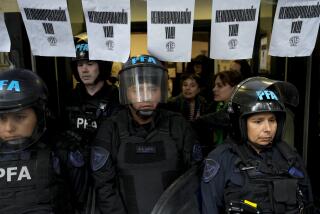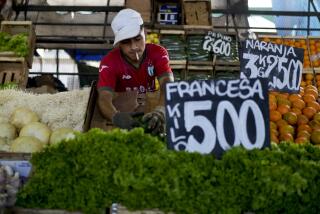Argentine Trade Offers Little Hope for Economy
- Share via
BUENOS AIRES — Trade often provides an economic escape hatch for countries that have suffered devaluations. Their weakened currencies make exports suddenly more competitive on international markets, fueling foreign exchange, business activity and job growth at home.
But trade prospects are dismal in Argentina, which recently devalued its currency. The reasons include a scarcity of credit and a long decline in technology investment that has left industry unprepared for an export push. A freeze on foreign currency transfers has brought deal-making to a halt, and political uncertainty has made exporters and their customers wary of new commitments.
A case in point is Sancor, a producer of dairy products based in Argentina’s Santa Fe province. Because the country’s banks essentially have shut down, the company is having trouble getting the credit it needs to export its powdered milk and cheese, even though it has a successful history of doing business in 35 countries.
“It’s very difficult to say what’s going to happen in Argentina. I wouldn’t dare, in the short- and midterm,” said Sancor export director Hernan Tevez. “Planning in this context is very difficult.”
The gloomy trade picture is one reason many observers are pessimistic about Argentina’s prospects for emerging from its economic crisis, at least in the short run.
Argentine exports are expected to decline by 5% this year, said Enrique Mantilla, president of the Argentine National Exporters Chamber, known by its Spanish initials CERA.
That’s despite the fact that the country’s goods are about half as expensive in dollars as they were before Argentina’s currency was devalued last month, when it abandoned its peg to the U.S. dollar and let the peso float freely on international markets.
When Brazil devalued its currency in 1999, its exports fell about 5% that year, but its economy still grew by nearly 1%. Argentina’s total economic output could shrink as much as 7% this year, its fifth year of negative economic growth.
Brazilwhiles exports roared back the year after its devaluation, but the prognosis for Argentina is much more clouded, given its other economic problems.
Argentina’s biggest trade handicaps are the collapse of its banking system and the unavailability of credit, which exporters need to finance production. With the Argentine government and corporations defaulting on billions in foreign debt, no one is rushing to lend firms money.
Financing for exports was much more available in post-devaluation Brazil, whose banking system withstood the crisis. In Mexico, many banks failed after the currency was devalued in 1994, but exporters frequently were able to access credit from their U.S. partners and customers. Argentine companies, on the other hand, are having to fend for themselves.
Because it has no idea how the nation’s currency will trade in coming weeks, steel manufacturer Siderar, which typically sells 55% of its production abroad, is reluctant to make deals. That uncertainty makes multimillion-dollar deals in thin-margin commodities such as steel highly risky propositions.
“This is where [exporters] are having the most difficulty, because no one knows what will happen with the dollar,” said Mantilla of CERA.
Even if Argentina’s banking system were in better shape, many companies would be ill-equipped to compete internationally, said Santiago Vexina, foreign trade director of the Argentina Chamber of Commerce. The nation’s investment in technology and machinery over the last 10 years has been woefully inadequate, he said.
That’s because the Argentine peso was so strong when it was tied to the dollar that it made more sense for manufacturers to import the components they needed rather than invest in the machinery, technology and know-how to make the upgrades themselves. Now, companies are paying the price: The devaluation has made such investments twice as expensive.
“Around half of what Argentina imports cannot be substituted by local suppliers, which is a problem for manufacturers,” Vexina said. “So the bad effects of the devaluation balance out the good effects.” Printing firms and packagers, which both rely on foreign components, have been especially hurt by the devaluation, he said.
Most economists said Argentina’s recovery hinges on an international assistance package, which many expect will include some sort of rescue for banks.
Without a viable banking system, Argentina will have trouble emerging from its crisis, said Paulo Levy, researcher at the Institute for Applied Economic Research, a Rio de Janeiro economic think tank.
In addition to a viable banking system, Brazilwhiles recovery was helped by its meeting austere fiscal goals in its devaluation year, keeping inflation under 10%.
Argentina won’t be so lucky. Inflation this year has been projected at 25% to 50%, and observers are worried the nation may print money to make up for a budget shortfall and reignite hyperinflation.
Although Brazilwhiles exports are only now beginning to pick up momentum, Brazilian producers had the advantage of having a domestic market four times the size of Argentina’s, said Sandra Rios, an economist with Brazil’s National Confederation of Industry.
In addition, Argentina’s domestic market is in the grips of a four-year recession.
“The devaluation in Brazil didn’t hurt domestic production, whereas it will in Argentina. That’s a big difference,” Rios said. “So Argentina will face a much more difficult period.”
Brazil also had an active government financing program for exports, something Argentina doesn’t have.
Like so many other facets of the economy, uncertainty rules Argentina’s exporters, said Mantilla of CERA.
“Before, we had a market-oriented economic model and now the government is imposing new regulations,” Mantilla said. “Until we know how it is all going to function, companies are on very uncertain footing.”
Amaury de Souza, a political economist with consulting firm Techne in Rio de Janeiro, said Argentina’s best hope may be to help foster the strengthening of Mercosur as an export platform to the rest of the world. Mercosur is a four-nation trade bloc composed of Brazil, Argentina, Paraguay and Uruguay.
*
Times researcher Vanessa Petit in Buenos Aires contributed to this report.
More to Read
Sign up for Essential California
The most important California stories and recommendations in your inbox every morning.
You may occasionally receive promotional content from the Los Angeles Times.













